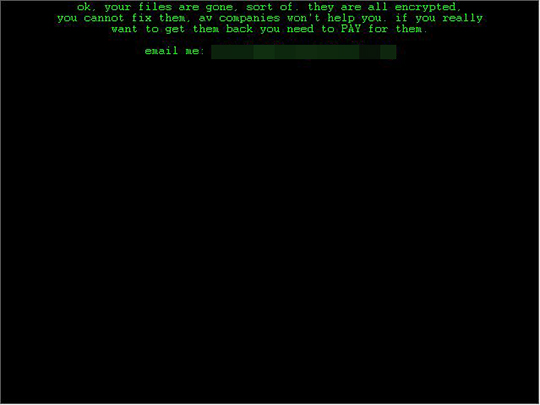RANSOM_DEKFOS.A
Artemis!5A843982BB52 (McAfee); HEUR:Trojan.Win32.Generic (Kaspersky); TR/Crypt.ZPACK.Gen (Avira)
Windows


Threat Type: Ransomware
Destructiveness: No
Encrypted: No
In the wild: Yes
OVERVIEW
This Ransomware drops files as ransom note.
TECHNICAL DETAILS
Installation
This Ransomware drops the following files:
- {Folders Containing Encrypted Files}\secret.key
- %User Temp%\BOLaoCrSE
(Note: %User Temp% is the user's temporary folder, where it usually is C:\Documents and Settings\{user name}\Local Settings\Temp on Windows 2000, Windows Server 2003, and Windows XP (32- and 64-bit); C:\Users\{user name}\AppData\Local\Temp on Windows Vista (32- and 64-bit), Windows 7 (32- and 64-bit), Windows 8 (32- and 64-bit), Windows 8.1 (32- and 64-bit), Windows Server 2008, and Windows Server 2012.)
It adds the following mutexes to ensure that only one of its copies runs at any one time:
- "W",9F,"",0C,"",EF,"IUzmY"
Other Details
This Ransomware displays a pop-up window with the following message:

It does the following:
- Exits program if file exists:
- %User Temp%\BOLaoCrSE
(Note: %User Temp% is the user's temporary folder, where it usually is C:\Documents and Settings\{user name}\Local Settings\Temp on Windows 2000, Windows Server 2003, and Windows XP (32- and 64-bit); C:\Users\{user name}\AppData\Local\Temp on Windows Vista (32- and 64-bit), Windows 7 (32- and 64-bit), Windows 8 (32- and 64-bit), Windows 8.1 (32- and 64-bit), Windows Server 2008, and Windows Server 2012.)
Ransomware Routine
This Ransomware avoids encrypting files found in the following folders:
- %System Root%\Users\Public
- %Windows%
- %Program Files%\Common Files
- %Application Data%
- %AppDataLocal%
- %ProgramData%
(Note: %System Root% is the Windows root folder, where it usually is C:\ on all Windows operating system versions.. %Windows% is the Windows folder, where it usually is C:\Windows on all Windows operating system versions.. %Program Files% is the Program Files folder, where it usually is C:\Program Files on all Windows operating system versions; C:\Program Files (x86) for 32-bit applications running on Windows 64-bit operating systems.. %Application Data% is the Application Data folder, where it usually is C:\Documents and Settings\{user name}\Application Data on Windows 2000, Windows Server 2003, and Windows XP (32- and 64-bit); C:\Users\{user name}\AppData\Roaming on Windows Vista (32- and 64-bit), Windows 7 (32- and 64-bit), Windows 8 (32- and 64-bit), Windows 8.1 (32- and 64-bit), Windows Server 2008, and Windows Server 2012.. %AppDataLocal% is the Application Data folder found in Local Settings, where it is usually C:\Documents and Settings\{user name}\Local Settings\Application Data on Windows 2000, Windows Server 2003, and Windows XP (32- and 64-bit); C:\Users\{user name}\AppData\Local on Windows Vista (32- and 64-bit), Windows 7 (32- and 64-bit), Windows 8 (32- and 64-bit), Windows 8.1 (32- and 64-bit), Windows Server 2008, and Windows Server 2012.. %ProgramData% is the Program Data folder, where it usually is C:\Program Files in Windows 2000, Windows Server 2003, and Windows XP (32- and 64-bit); C:\ProgramData in Windows Vista (32- and 64-bit), Windows 7 (32- and 64-bit), Windows 8 (32- and 64-bit), Windows 8.1 (32- and 64-bit), Windows Server 2008, and Windows Server 2012.)
It appends the following extension to the file name of the encrypted files:
- .fff
It drops the following file(s) as ransom note:
- {Folders Containing Encrypted Files}\READTHISHIT.txt
It leaves text files that serve as ransom notes containing the following text:
- ok, your files are gone, sort of. they are all encrypted,
you cannot fix them, av companies won't help you. if you really
want to get them back you need to PAY for them.
email me: sofucked@{BLOCKED}eechmail.org
SOLUTION
Step 1
Before doing any scans, Windows XP, Windows Vista, and Windows 7 users must disable System Restore to allow full scanning of their computers.
Step 2
Note that not all files, folders, and registry keys and entries are installed on your computer during this malware's/spyware's/grayware's execution. This may be due to incomplete installation or other operating system conditions. If you do not find the same files/folders/registry information, please proceed to the next step.
Step 3
Restart in Safe Mode
Step 4
Search and delete these files
- {Folders Containing Encrypted Files}\secret.key
- {Folders Containing Encrypted Files}\READTHISHIT.txt
- %User Temp%\BOLaoCrSE
Step 5
Restart in normal mode and scan your computer with your Trend Micro product for files detected as RANSOM_DEKFOS.A. If the detected files have already been cleaned, deleted, or quarantined by your Trend Micro product, no further step is required. You may opt to simply delete the quarantined files. Please check this Knowledge Base page for more information.
Step 6
Restore encrypted files from backup.
Did this description help? Tell us how we did.

